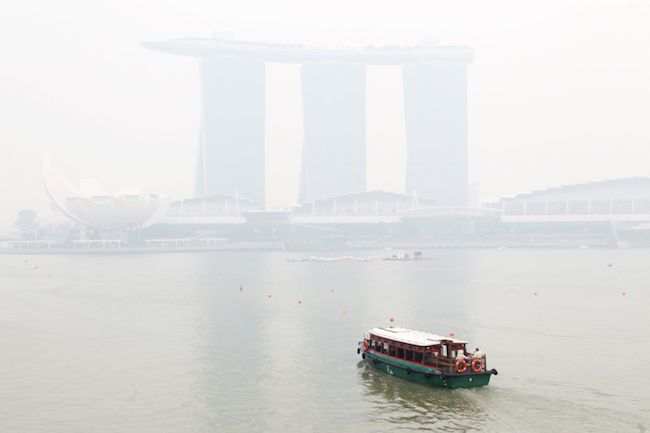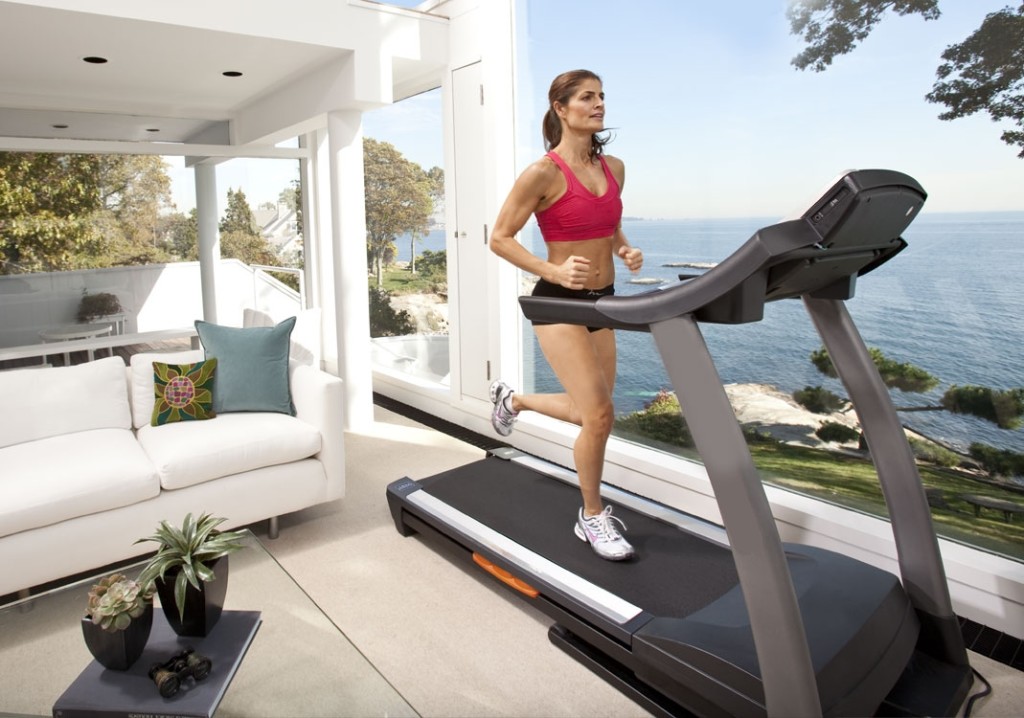Elite Singaporean marathoner Dr Derek Li Shi’ An, 33, is a Medical Doctor with the Raffles Medical Group, and so he is very cautious with his own health – when it comes to running and training for races. This is especially so, now that the haze is back in full force and the PSI, according to the National Environmental Agency’s (NEA) readings, has been regularly exceeding 100 every day without fail, for the past few days already.

The haze is now back in full force in Singapore. Photo Credit: vulcanpost.com
Why the haze is harmful
Explained Dr Li, on why the haze is harmful, “It is generally accepted that any kind of outdoor exercise should be curtailed once the PSI goes over 100. The increased foreign particle density in the air makes oxygen transfer in the lungs less efficient, causing your heart rate to generally be higher than usual and you may also sweat more than usual during exercise.”
Added the doctor, who has a full marathon personal best of 2 hours and 42 minutes, set at the Boston Marathon in April 2014, “This is particularly true (the haze being harmful) for people with airway sensitivity or other respiratory problems like asthma. The haze stimulates a greater production of mucus in the airway lining through inflammation processes, further hampering oxygen transfer within the lungs. Unfortunately this applies to other forms of cardiovascular exercise such as swimming or cycling too.”

With Dr Derek Li (left)
According to Dr Li, some of the side-effects of the haze can include eye irritation and red eyes (a form of conjunctivitis), especially with prolonged exposure and unchecked, conjunctivitis can lead to further downstream problems with ulcers. Added Dr Li, “It can also cause skin allergies such as eczema and urticaria (hives) to flare up as well. Finally, it can cause airway irritation and manifest as conditions like allergic rhinitis, pharyngitis (throat inflammation) and bronchitis or asthma.”
So the doctor also added that he personally would adjust his outdoor training sessions to indoor ones, if the haze gets in the way of a scheduled training session. He said, “For training sessions, I am very happy to adjust the run to be done on a treadmill indoors. I am someone who often does his interval runs on a treadmill anyway, so I have no problems substituting an outdoor run for an indoor one.”
Taking part in races when the haze is high
And when it comes to taking part in running races, the same rules apply too, according to Dr Li. He said, “I believe there have been some instances in the past where races were cancelled or postponed due to hazy conditions. The toll of poor air quality can be higher during the race conditions, because the body is working at a higher intensity and make a big difference in terms of performance and perceived effort. If you happen to be sensitive to haze, then I would strongly encourage you to err on the side of caution. For ultra running, distance events in particular, you are spending many hours outdoors, so it is important to continually re-assess the air quality and your perceived effort during the race.”
Dr Li also added that he himself, would sacrifice a race too, if the PSI levels are too high on the day of the race. He said, “It would probably depend on the importance of the race. I do have some degree of airway sensitivity and I tend to cough a little after a run in PSI 80-100 air quality, so I know that if it’s even a little hazy, my performance in that race won’t be good anyway. I think the only time I would risk it is if it were some form of team event, where there is a great obligation to do your part. I don’t believe in racing when you are not able to put in your best effort, and would have no problems forfeiting a race if I feel the conditions are unhealthy.”
Wearing N95 masks to run

Try to wear an N95 mask to run.
Photo credit: link2life.ca
While some runners may take to wearing N95 masks when they run during the haze season, the doctor though, does not think that this is a completely effective solution. He said, “You must ensure that the mask has a good seal on the face. In medical practice, we use strong-smelling products like vanilla or coffee extracts to test if the mask fits correctly. If the seal is loose the mask is as good as useless. Regular face masks do not work. So I would recommend giving the N95 a try if you really prefer to run outdoors.”
However Dr Li added that personally, he didn’t have a very good experience himself, while wearing an N95 mask to run. He explained, “I have to say that it is not very comfortable, plus the heavy breathing action has the potential to disrupt the seal of the mask, allowing haze particles to seep in. I think running indoors on a treadmill is still a more convenient and viable option.”
The doctor added that N95 masks in particular are used during hazy conditions, because they have a much finer filtration system so that they can trap smaller particles and prevent them from being inhaled, compared to a regular surgical face mask. He explained, “Normal face masks are really only useful for very large air particles and respiratory droplets. They do not prevent the inhalation of PM2.5 particles. I would recommend wearing an N95 mask for PSI above 100 during exercise and PSI above 200 for daily outdoor activities.”
A word of advice for runners who won’t let the haze keep them away
For runners who refuse to let the haze keep them away from their regular outdoor runs, Dr Li has a word of advice for them. He said, “They are almost definitely going to train slower when they are running in hazy conditions because the body is under more strain and the benefit of that training will be less. Say for example, you normally run 6.00min/km pace at a heart rate of 150 beats per minute (bpm) in good air quality. At a PSI of 120, you might run 6.00min/km pace at 160bpm, or 6.30min/km pace at 150bpm. Either way, the training would be less efficient and produce less fitness benefit than if you ran that 6.00min/km at 150bpm on a treadmill.”
He continued, “In my opinion, in a Singapore context, the only benefits of outdoor running are firstly, you are adapting to the heat and humidity in which your races are going to be run, and secondly, you are beating the monotony of a treadmill.”
Monitor the daily PSI trends when you run
So in that regard, to train for a marathon race – when the high PSI is attempting to foil your plans – Dr Li suggests that you should monitor the daily PSI trends and find out which time of day the PSI is at its lowest.
He said, “The haze has foiled my plan once before in 2013, when I was preparing for the Gold Coast Marathon on 7 July that year. Fortunately i did have easy access to a treadmill, but for people who don’t, look at the PSI trends and you will see that the best chance of a lower PSI reading (in the borderline range of PSI 80 to 100) tends to be in the early morning around 5-7am. That’s probably your best chance to get out there and run – but please still do wear a mask.”
But Dr Li added that if the PSI is never lower than 150, then there is probably no chance to get out of joining a gym to get in your training sessions. Said Dr Li, “Even with a mask on, a PSI above 150 has a good chance of irritating your eyes and skin, if you are out there running for prolonged periods. Marathon training relies a lot on specificity of joint and muscle endurance and time on your feet is more crucial than anything else in preparing for a marathon.”
Click here for how some of Singapore’s top runners have been coping with the haze.
Click here for more about deadly health effects caused by the haze.



Indonesia government should assume responsibility and take extreme actions to stop this. It has been going on for too long. ASEAN countries should not allow this and interfere, non interference in neighbouring countires issues is like sitting on the fence while someone commits a crime and we can prevent it. !!
Based on recent news reports, it’s good to hear that Indonesia is doing something about it now.
Yes the haze affects us all more than we think. Even if you don’t feel the effects now, you may feel them down the road. So take care of yourself – you only have one life.